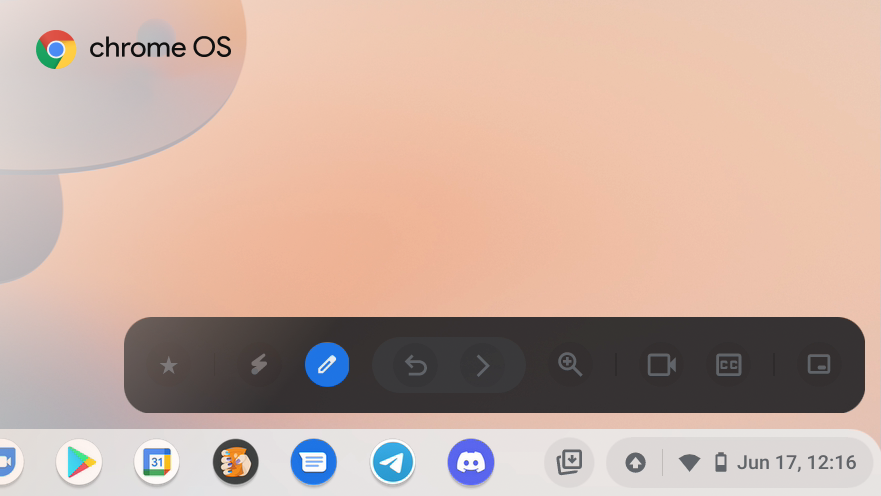It's been many months since we covered Projector for Chromebooks — an upcoming presentation tool for students and educators. Google has since been working behind the scenes to finish up this new feature for Chromebooks, and thanks to a recent update, we have a near-finalized look at how it plans to amp up online presentations.
Projector has received many under-the-hood changes, picking up handfuls of nifty extra features along the course of development. There's good news for intrepid users on the Chrome OS Dev channel interested in it: a recent update implements its flags so you can try it out. Copy and paste the following addresses (in bold) into Chrome's URL bar and select Enabled from the drop-down menu:
chrome://flags/#enable-projector-feature
Enables projector feature flag to be used — Chrome OS
chrome://flags/#enable-projector-feature-pod
Enables showing the projector feature pod in system stray — Chrome OS
Once you've rebooted, you'll be able to activate Projector from the quick settings under Presentation tools. Here a hands-on look at its capabilities.
Up your presentation game with a "laser pointer"
Whether you're in a corporate setting or a student, it's likely that you'll have to give a presentation at one point in your career. A faux laser pointer helps keep your audience engaged by directing their attention to a key idea or imagery on your PowerPoint slides.
Using Projector's laser pointer feature on Google Slides.
Activating the built-in laser pointer is as simple as selecting its icon on the left side of the bar (next to the "key idea" star). Chrome OS will replace the cursor with a red dot — moving it around creates a neat translucent trail behind the marker. With it, you can easily point out a specific detail on a presentation. The pointer is buggy right now — its intermittent "jumps" are jarring, but we imagine Google will fix the laser pointer in a future update.
Annotate your slides using a selection of drawing tools
As you're delivering a presentation, you might need to add annotations to your slides to incorporate notes from a discussion. While some software offers the ability to mark up your slides, Projector has a collection of drawing tools you can use to make your presentation even more engaging.
[video width="1920" height="1080" mp4="https://www.androidpolice.com/wp-content/uploads/2021/06/16/cros_projector_markup.mp4" loop="true" autoplay="true"]
Projector offers markup tools to help write notes onto your slides.
Clicking on the pencil icon next to the laser pointer will activate the markup tool, allowing you to ink-over your slides. You can customize the tool's colors or swap to a highlighter by expanding the menu, and there's an option to undo or erase the strokes you've annotated in case you've made a mistake. You won't be able to change your pen tools or colors for now — we expect a future Chrome OS update will finish the feature.
Zoom to parts of your slide with Projector's magnifier tool
A screen magnifier is an excellent way to direct your audience's focus on parts of an image in your slide. It's especially useful when pointing out a specific spot on a map or details in a painting. With Projector's built-in magnifier, you won't need to create a custom picture effect to give a magnified appearance.
[video width="1920" height="1080" mp4="https://www.androidpolice.com/wp-content/uploads/2021/06/16/cros_projector_magnifier.mp4" loop="true" autoplay="true"]
Magnifier feature zooms into your slides.
It's easy to enable the magnifier feature — simply click on the magnifying glass icon on Projector's bar to get started. A large "circle" will show up, aligned centered to your cursor. Its 2x zoom helps give your audience a better view of the imagery attached onto your slides. The magnifier could double as an accessibility feature for those with impaired vision, too.
Narrate your presentation using Projector's handy video tools
Video presentations are great to spread your ideas and create an emotional connection with your viewers. Projector for Chrome OS allows you to record yourself presenting your slides — all while offering the ability to keep up with text through Google's powerful Live Caption.
Live Caption works with your speech and video playback.
Turning on the webcam and Live Caption is as simple as clicking on the video and "CC" icon on the Projector bar. Live Caption will automatically transcribe your speech when you start talking, helping viewers follow along with you easier. (You can also use it to caption your professor's lecture, too.)
Adding a collection of easy-to-use presentation tools is a welcome change for the education and enterprise markets in this virtual setting. Since Projector is only available to test on the Dev and Canary channels, you'll have to wait a bit before it rolls out to everyone. The feature is not perfect, either — there are some pointer and inking bugs that need to be ironed out, and it's unclear what the "key idea" button does. While it's probably not going to find its way into my workflow anytime soon, I can see it being useful for students who want their presentations to be more engaging.

